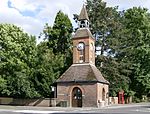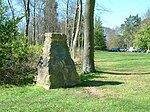Princess Mary's Royal Air Force Hospital Halton
1919 establishments in EnglandBritish military hospitalsDefunct hospitals in EnglandHospital buildings completed in 1927Hospitals in Buckinghamshire ... and 6 more
Military hospitals in the United KingdomMilitary units and formations disestablished in 1996Military units and formations established in 1919Royal Air Force Medical ServicesRoyal Air Force stations in BuckinghamshireUse British English from December 2021

The Princess Mary's Royal Air Force Hospital Halton, was the first Royal Air Force hospital to be built that was dedicated to air force personnel. Located on what was then the largest of the RAF camps at RAF Halton in Buckinghamshire, England, the hospital treated over 20,000 patients during the Second World War and was the first place in the world to use penicillin on a large-scale. The hospital continued in use throughout the Cold War, only closing in 1996 due to defence cuts.
Excerpt from the Wikipedia article Princess Mary's Royal Air Force Hospital Halton (License: CC BY-SA 3.0, Authors, Images).Princess Mary's Royal Air Force Hospital Halton
Whittingham Avenue,
Geographical coordinates (GPS) Address Nearby Places Show on map
Geographical coordinates (GPS)
| Latitude | Longitude |
|---|---|
| N 51.769 ° | E -0.729 ° |
Address
Whittingham Avenue
Whittingham Avenue
HP22 5GU
England, United Kingdom
Open on Google Maps








